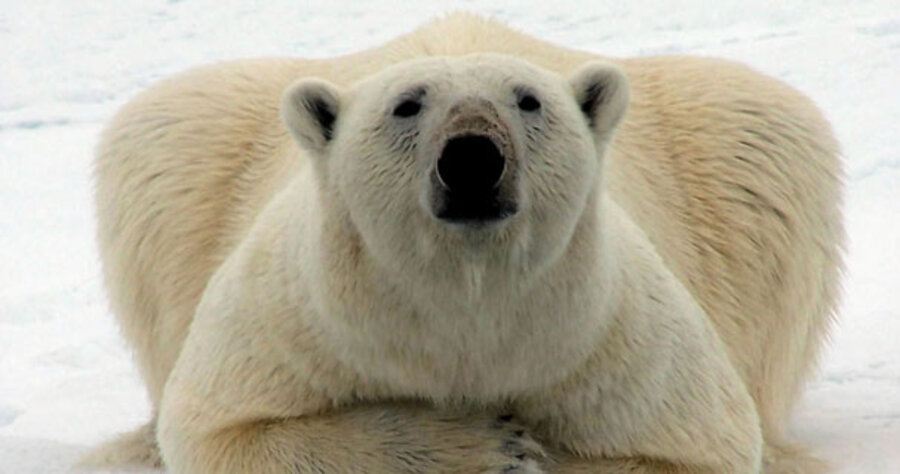What polar bears get from new protected status
Loading...
The Interior Department’s long-awaited decision to list the polar bear as a threatened species was a victory, of sorts, for the bear.
It came as a surprise to many who expected the Bush administration to avoid the listing, due to worries that it would curb oil and gas exploration in the bears’ habitat or, worse, make every emitter of greenhouse gases answerable to the Endangered Species Act (ESA).
But in announcing the new threatened status, the administration simultaneously specified unusual stipulations designed to mitigate those effects.
“I truly believe I made the right decision,” says Interior Secretary Dirk Kempthorne. “I did it so that yes, we’ll protect the bear. But we’re also not going to adversely impact the development of oil and gas that the country needs.”
Environmental groups immediately praised the landmark listing, at the same time that they criticized the limits placed on it, in some cases promising to sue to get stricter measures adopted.
“This is an historic moment. It’s the clearest acknowledgment to date we’ve had from this administration of global warming’s urgency,” says Kassie Siegel, a lawyer with the Center for Biological Diversity, one of three groups that had sued the administration over its long delays in making the decision. “But they’re also simultaneously acting to reduce the protection the bear would get under the law.”
With its new status, the polar bear will see a few tangible changes: Hunters can no longer bring trophies back to the US, and new studies and a recovery plan will be mandated.
But broader impacts are likely to be few. The listing includes a special rule about greenhouse-gas emissions, noting that they can’t and shouldn’t be regulated by the Endangered Species Act.
Secretary Kempthorne took care to note that greenhouse-gas emissions can’t and shouldn’t be regulated by the ESA, issuing a special order to that effect. It’s an action he says is important to prevent unintended economic consequences – new power plants blocked, for instance, or individual emitters sued – and which he says is consistent with science, since it can’t make the direct causal connection required by the ESA between the emissions from one particular source and the death of a bear in the North.
“When the Endangered Species Act was adopted in 1973, I don’t think the term climate change was in our vernacular,” he says, expressing frustration with the inflexible tools available to him.
In addition, the department is using a so-called “4(d) rule” to lessen the impact on oil and gas companies. The rule merges the ESA requirements with those of the Marine Mammals Protection Act (MMPA), with which oil and gas companies have already had to comply since 1972. Exploration already allowed – including the controversial leases granted in February for 29 million acres in the Chukchi Sea, home to one of two US polar bear populations – will still be legal. Environmentalists have questioned the logic, noting that the MMPA only deals with harm to individual animals, while the ESA regulates habitat protection.
The Chukchi Sea lease sale “was a double whammy for the polar bear,” says Margaret Williams, managing director of the World Wildlife Fund’s Alaska Office. “Here we are adding more pressure on habitat which is already under stress, and we’re making it possible to further increase CO2 emissions.”
But if environmental groups were disappointed that the listing didn’t go far enough, others were angry that the polar bear was listed at all. They note that its population is currently estimated at around 25,000 – significantly higher than it was just 50 years ago.
“The species is thriving currently,” says Reed Hopper, principal attorney with the Pacific Legal Foundation, which plans to sue to reverse the listing.
Mr. Hopper calls the idea that the special rules can prevent economic impact “wishful thinking,” noting that the administration can’t dictate to the courts, who must establish things like a causal connection between carbon dioxide emitters and polar bear decline.
“Considering the tremendous social upheaval that could result from these lawsuits, we think the agency should have been more prudent and decided not to list [the bear],” says Hopper.
Hopper criticizes a decision made on “speculative projections,” but consensus emerged from the scientific studies used to make the listing: Sea ice, necessary to the polar bear’s survival, is melting dramatically and is likely to further recede. Within the next 45 years, all the models predicted the bears are likely to be endangered.
Given that science, the listing, however limited, “does protect the integrity of the Endangered Species Act,” says Ms. Williams. Kempthorne says that no one should expect the listing to halt the destruction of arctic sea ice – but hopes that the decision might spur other action on climate change.
“I think this can help generate a good discussion among the major economies to talk about what we need to do together,” he says.





